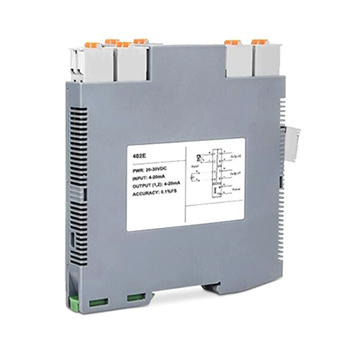How does a Signal Isolator Work?
The isolator uses a kind of linear optocoupler isolation principle, which converts the input signal and outputs it. Input, output and working power are isolated from each other, especially suitable for use with equipment and meters that require electrical isolation. Isolator, also known as signal isolators, is an important part of industrial control systems. Therefore, today we going to introduce signal isolator to you and we hope that you can know how does it work after reading.
How it works
The realization of monitoring and control in the industrial production requires the use of various automated instruments, control systems and actuators. The signal transmission between them includes small signals ranging from weak to millivolts and micro-amps, and large signals of tens of volts, or even thousands of volts and hundreds of amperes. There are both low-frequency DC signals and high-frequency pulse signals and so on. When various devices form a system, it is often found that the signal transmission between the instrument and the device interferes with each other, causing the system to be unstable or even misoperation. In this case, in addition to the performance reasons of each instrument and equipment itself, such as anti-electromagnetic interference, there is also a very important factor. Due to the potential difference between the signal reference points between the instrument and the equipment, it forms a “ground loop” which causes distortion during signal transmission. Therefore, to ensure the stable and reliable operation of the system, the "ground loop" problem is a problem that must be solved in the process of system signal processing.
Solutions to “Ground Loops”
Based on theoretical and practical analysis, there are three solutions:
The first solution: All field devices are not grounded, so that all process loops have only one grounding point and cannot form a loop. This method seems simple, but it is often difficult to achieve in practical applications because some equipment must be grounded to ensure measurement accuracy or to ensure personal safety. Some equipment may form a new ground point due to long-term corrosion and wear or weather.
The second scheme: Make the potential of the two grounding points the same. However, since the resistance of the grounding point is affected by many factors such as geological conditions and climate change, this scheme cannot be fully implemented in practice.
The third solution: Use the signal isolation method in each process loop to disconnect the process loop without affecting the normal transmission of the process signal, thus completely solving the ground loop problem.
Power supply
Common power supply methods for isolators include independent power supply and loop power supply.
Independently powered isolators:
An independent 20~35VDC power supply is required. The advantage of this method is that the isolation transmission accuracy is high. The power supply, input and output are completely isolated, and the power supply of the multi-channel system does not need to be isolated. High anti-interference performance can be guaranteed, and the input signal can be converted to other types of models.
Loop powered isolators:
In the actual industrial monitoring system, the use of DCS, PLC or other display instruments with internal power supply of the card is more and more widely used. Loop-powered isolators often cannot meet the high requirements of these cards for signal isolation and transmission accuracy and the high requirements for distribution voltage of two-wire transmitters. Therefore, the isolator of the output loop power supply type not only retains the superior performance of the independent power supply type isolator, but also meets the requirements of the output loop power supply interface.
Advantages
The use of signal isolation methods in each process loop can be achieved by using isolation cards such as DCS or PLC, or on-site transmitters with isolation (some devices can do it), or signal isolators. In comparison, using a signal isolator has the following advantages:
- In most cases, it is cheaper to use signal isolator + non-isolated card than to use isolated card.
- Signal isolators are more superior in isolation capability and anti-electromagnetic interference than isolation cards.
- The application of the signal isolator is flexible, and it also has the function of model conversion and signal distribution, which is more convenient to use.
- Signal isolators usually have single channel, dual channel, one input and two output channels, etc. The channels are completely independent of each other, which makes the configuration and daily maintenance of the system more convenient.

